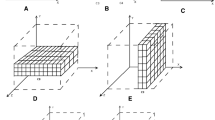Abstract
In this paper, we propose a new algorithm for clustering multi-dimensional time series (MDTS). It is based on the predictive clustering paradigm, which combines elements of predictive modelling and clustering. It builds upon the algorithm for predictive clustering trees for modelling time series, and extends it to model MDTS. We also propose adequate distance functions for modelling MDTS. We apply the newly developed approach to the task of analyzing data on forest growing stock in state-owned forests in Slovenia. This task of high importance, since the growing stock of forest stands is a key feature describing the spatio-temporal dynamics of the forest ecosystem response to natural and anthropogenic impacts. It can be thus used to follow the structural, functional and compositional changes of forest ecosystems, which are of increasing importance as the forest area in Europe has been growing steadily for the last 20 years. We have used two scenarios (quantitative and qualitative) to analyze the data at hand. Overall, the growing stock in Slovenian forests has been increasing in the last 40 years. More specifically, the growing stock of the three tree-size has progressive dynamics, which indicates that Slovenian state-owned forests have balanced structure.
Access this chapter
Tax calculation will be finalised at checkout
Purchases are for personal use only
Similar content being viewed by others
References
McElhinny, C., Gibbons, P., Brack, C., Bauhus, J.: Forest and woodland stand structural complexity: its definition and measurement. For. Ecol. Manage. 218(1–3), 1–24 (2005)
Jørgensen, S.E., Bendoricchio, G.: Fundamentals of Ecological Modelling. Elsevier, Padova (2001)
Rules on the forest management and silviculture plans. Official Gazette of the Republic of Slovenia, no. 5/1998 of 23-1-1998 (1998)
Liao, T.W.: Clustering of time series data-a survey. Pattern Recogn. 38(11), 1857–1874 (2005)
Blockeel, H.: Top-down induction of first order logical decision trees. Ph.D thesis, Katholieke Universiteit Leuven, Leuven, Belgium (1998)
Kaufman, L., Rousseeuw, P. (eds.): Finding Groups in Data: An Introduction to Cluster Analysis. Wiley, Hoboken (1990)
Blockeel, H., Raedt, L.D., Ramon, J.: Top-down induction of clustering trees. In: Proceedings of the 15th International Conference on Machine Learning, pp. 55–63. Morgan Kaufmann (1998)
Džeroski, S., Gjorgjioski, V., Slavkov, I., Struyf, J.: Analysis of time series data with predictive clustering trees. In: Džeroski, S., Struyf, J. (eds.) KDID 2006. LNCS, vol. 4747, pp. 63–80. Springer, Heidelberg (2007). doi:10.1007/978-3-540-75549-4_5
Quinlan, J.: C4.5: Programs for Machine Learning. Morgan Kaufmann Series in Machine Learning. Morgan Kaufmann, San Francisco (1993)
Todorovski, L., Cestnik, B., Kline, M., Lavrač, N., Džeroski, S.: Qualitative clustering of short time-series: a case study of firms reputation data. In: ECML/PKDD 2002 Workshop on Integration and Collaboration Aspects of Data Mining, Decision Support and Meta-Learning, pp. 141–149 (2002)
Poljanec, A.: Changes in forest stand structure in Slovenia in period 1970–2005. Ph.D thesis, Biotechnical Faculty, University of Ljubljana, Slovenia (2008)
Debeljak, M., Poljanec, A., Ženko, B.: Modelling forest growing stock from inventory data: a data mining approach. Ecol. Ind. 41, 30–39 (2014)
Acknowledgement
We would like to acknowledge the support of the European Commission through the project MAESTRA - Learning from Massive, Incompletely annotated, and Structured Data (Grant number ICT-2013-612944).
Author information
Authors and Affiliations
Corresponding author
Editor information
Editors and Affiliations
Rights and permissions
Copyright information
© 2017 Springer International Publishing AG
About this paper
Cite this paper
Gjorgjioski, V., Kocev, D., Bončina, A., Džeroski, S., Debeljak, M. (2017). Predictive Clustering of Multi-dimensional Time Series Applied to Forest Growing Stock Data for Different Tree Sizes. In: Trajanov, D., Bakeva, V. (eds) ICT Innovations 2017. ICT Innovations 2017. Communications in Computer and Information Science, vol 778. Springer, Cham. https://doi.org/10.1007/978-3-319-67597-8_18
Download citation
DOI: https://doi.org/10.1007/978-3-319-67597-8_18
Published:
Publisher Name: Springer, Cham
Print ISBN: 978-3-319-67596-1
Online ISBN: 978-3-319-67597-8
eBook Packages: Computer ScienceComputer Science (R0)




